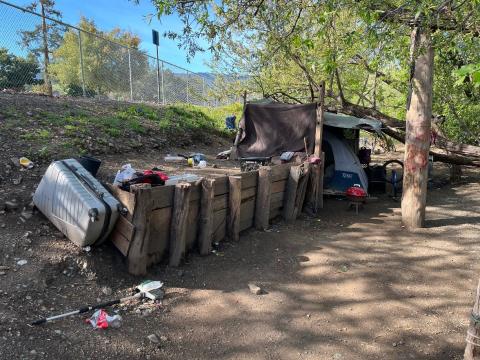Gilroy and South Bay Extended Weather Forecast
As storm season approaches, residents brace for impact
Valley Water and partner agencies collaborate to prepare for an unpredictable season By Calvin Nuttall With winter weather rapidly descending, officials from Valley Water, the National Weather Service and other local agencies gathered to advise [...]
Editorial: Protect water resources while addressing homelessness
This task demands the board’s utmost attention and ethical consideration.
![]()
This editorial is the opinion of Gilroy Life

Guadalupe Creek in San Jose has many encampments. Photo courtesy Valley Water
The Valley Water Board of Directors chose in July to postpone voting on a proposed ordinance aimed at reducing encampments along waterways. Their decision highlights the complex challenges faced by local authorities in balancing environmental protection with compassionate approaches to homelessness.
 While the intention behind the Water Resources Protection Zones ordinance is laudable — safeguarding water resources, endangered species, and the safety of Valley Water staff — the board’s decision to revisit the proposal demonstrates a commendable willingness to consider public input and seek more comprehensive solutions. At the heart of this issue lies a profound ethical dilemma the board must grapple with: how to balance protecting our natural environment around streams with the equally pressing moral obligation to provide humane shelter and improve the quality of life for Santa Clara County’s homeless population.
While the intention behind the Water Resources Protection Zones ordinance is laudable — safeguarding water resources, endangered species, and the safety of Valley Water staff — the board’s decision to revisit the proposal demonstrates a commendable willingness to consider public input and seek more comprehensive solutions. At the heart of this issue lies a profound ethical dilemma the board must grapple with: how to balance protecting our natural environment around streams with the equally pressing moral obligation to provide humane shelter and improve the quality of life for Santa Clara County’s homeless population.
This ethical quandary is not unique to Valley Water, but it is particularly acute given the agency’s mandate to safeguard critical water resources. The board must weigh the environmental impact of encampments — including potential water contamination and damage to riparian ecosystems — against the human cost of displacing vulnerable individuals without providing viable alternatives.
The planned summit in October represents a crucial opportunity for collaboration among local leaders, businesses, nonprofits, and advocacy groups. This inclusive approach is essential for developing strategies that address both the environmental concerns and the humanitarian aspects of the encampment issue. It is imperative this summit not only focuses on environmental protection but also explores innovative solutions for providing dignified, safe housing options for the homeless.
Valley Water’s emphasis on an educational approach rather than criminalization is a step in the right direction. However, the challenge lies in implementing such measures effectively while ensuring vulnerable populations are not further marginalized. The board should consider partnering with social service organizations to provide resources and support to those displaced by any future ordinance.
As stewards of nearly 300 miles of creeks and rivers in Santa Clara County, Valley Water bears significant responsibility for environmental protection. Yet, this responsibility must be balanced with the broader societal issue of homelessness, which requires a multifaceted, compassionate approach.
The South Valley’s cities of Morgan Hill and Gilroy have witnessed a troubling increase in homeless encampments along local creeks in recent years. This trend has brought the ethical dilemma into sharp focus. While local nonprofit groups and individual volunteers have responded compassionately by providing food to those living in these encampments, their efforts have inadvertently contributed to environmental concerns. The use of Styrofoam containers for food distribution, while practical for serving, has led to a significant litter problem in and around the creeks.
This situation demonstrates the complex interplay between addressing human needs and protecting the environment. It underscores the necessity for a comprehensive approach that not only provides for the homeless but also considers the environmental impact of well-intentioned humanitarian efforts. The Valley Water board must take into account these local dynamics when formulating its policy, perhaps by exploring partnerships with these community groups to implement more environmentally friendly food distribution methods while continuing to serve those in need.
The postponement of the vote should be seen as an opportunity to develop a more nuanced, holistic strategy that should not only protect water resources but also address the root causes of homelessness and provide sustainable solutions for those living in encampments.
 Moving forward, it is crucial Valley Water and other stakeholders work together to find innovative approaches that protect both the environment and the dignity of all residents. This may involve exploring alternative housing solutions, expanding social services, and implementing more comprehensive outreach programs.
Moving forward, it is crucial Valley Water and other stakeholders work together to find innovative approaches that protect both the environment and the dignity of all residents. This may involve exploring alternative housing solutions, expanding social services, and implementing more comprehensive outreach programs.
How we address these complex, intersecting problems will be a testament to our values as a society. It is our hope that the upcoming summit and revised ordinance will set a precedent for thoughtful, inclusive policymaking that serves all members of the community while safeguarding our vital natural resources.
Ultimately, the board must craft a policy that upholds its environmental responsibilities while also embodying the compassion and social consciousness expected of public institutions in addressing the homelessness crisis. This is no easy task, but it is one that demands our utmost attention and ethical consideration.



